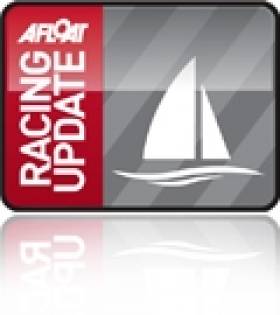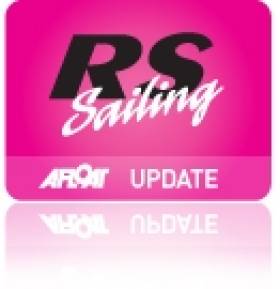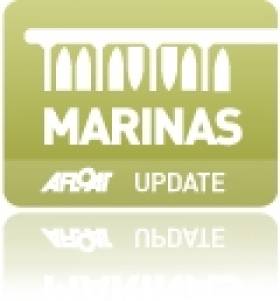Displaying items by tag: Royal St George
#disabledsailing – 13 sailors from Dun Laoghaire, Kinsale and Galway took part in a very closely fought Access Sailing National Championship regatta competition in the specially designed dinghies for disabled sailing in near perfect conditions in Dun Laoghaire harbour at the weekend.
The Royal St George Yacht Club were hosts for the second Access Sailing National Championship Regatta which was held last weekend as a fun competitive event that will hopefully encourage other clubs around the country to get children with disability out on the water.
After 6 races, the overall winner of the Girls Trophy was Georgina Griffin from Kinsale and the Boys Trophy was Oisin Putt on his home waters of Dun Laoghaire.
RS400, RS200 & RS Feva 2013 Royal St George Easterns
The three RS classes battled it out last weekend at the Seapoint end of Dublin Bay for the season's first event, the Eastern Championships. The event attracted a total entry of thirty five boats with nineteen RS400's, eleven RS200's and six Fevas.
Full results are available to download as a pdf file below
Race Officer Barry Mac Neaney assisted by Jimmy Murphy and his crew on the committee boat "Lady Beag" from Poolbeg Yacht Club did a fantastic job to promptly fire off four races on Saturday in shifty and testing conditions with strong tides added in for good measure. The final two races were sailed in stronger gusty conditions on Sunday, which proved a stern but exciting test for all crews.
In the RS400 class there was a three-way tussle at the top between Bob Espey & Michael Gunning of Ballyholme YC/Royal Ulster YC, Emmet & James Ryan of The Royal St George YC and Mike "Chunky" Ferguson & Jeremy Tomalin of Ballyholme YC/Royal Ulster YC. The three boats appeared to be tied together by a piece of string for much of Saturday's four races with only a two point gap separating first and third overnight.
In Sunday's first race for the 400's a slight miscount of laps by the majority of the fleet left the top two of Bob Espey/Michael Gunning and Emmet/James Ryan to fight it out in a match race which left both on equal points for the final race. Bob and Mike took the final race in strengthening wind conditions and with it the RS400 Easterns.
In the RS200's it was local class newcomers Conor Totterdell & Myles Kelly who topped the fleet taking both the overall and junior trophies. This was a great achievement in a range of trying conditions. Conor & Myles are sure to be a force to be reckoned with this season, particularly with the Dún Laoghaire RS fleet growing in numbers and talent. Second in the RS200's was Newcastle YC's Clive Coffey & Helen Cassidy. The 2012 Traveller Series

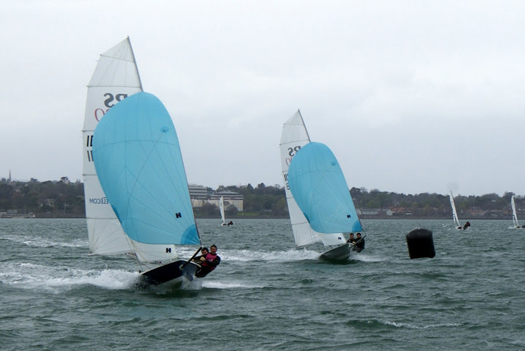
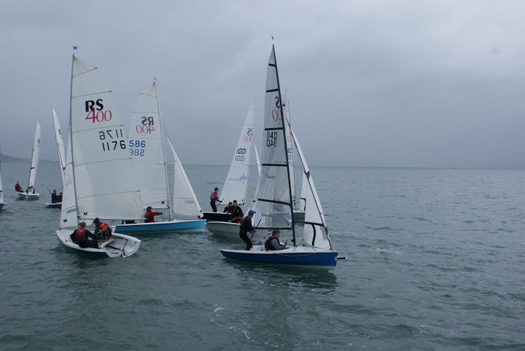
RS action at the Eastern Championships on Dublin Bay. Photos Sean Cleary
Champions from Newcastle once again proved ever consistent performers over the weekend. In third place and taking over the helm form his Dad Sean for the first time was Stephen Craig and his crew Conor Foley. Stephen & Conor had an unfortunate last race which in the end cost them the event. No doubt they will be back fighting for top spot at the next RS event in Greystones on the 22th of June.
The Feva class benefitted from on the water coaching throughout the event and this definitely helped to iron out any early season creases by the end of the six races. Jack & Henry Higgins grew massively in confidence over the series and counted three bullets from the last three races. Emer Rafferty & Laura Coleman gave the Higgins brothers a great run for their money and finished just one point off top spot. Dara Donnelly & Rosemary Tyrrell put in a very solid six races to finish up in third place.
Top 3 RS400's
Place Helm Crew R1 R2 R3 R4 R5 R6 Total
1st Bob Espey Mike Gunning 1 3 2 1 2 1 7
2nd Emmet Ryan James Ryan 2 1 3 2 1 3 9
3rd Mike Ferguson Jeremy Tomalin 5 2 1 3 DNF 2 13
Top 3 RS200's
Place Helm Crew R1 R2 R3 R4 R5 R6 Total
1st Conor Totterdell Myles Kelly 2 1 2 2 3 6 10
2nd Clive Coffey Helen Cassidy 3 4 1 3 5 2 13
3rd Stephen Craig Conor Foley 4 3 3 1 2 7 13
Top 3 RS Feva's
Place Helm Crew R1 R2 R3 R4 R5 R6 Total
1st Jack Higgins Henry Higgins 4 5 2 1 1 1 9
2nd Emer Rafferty Laura Coleman 1 3 1 3 2 4 10
3rd Dara Donnelly Rosemary Tyrrell 3 4 3 2 4 2 14
The Royal St. George Yacht Club in Dun Laoghaire harbour offers fully serviced berthing for yachts up to 70ft with pontoons automatically lit and are equipped with shore power. Nightly rates are available. A security card service for visitors gives access to the Yacht Club.
#cluboftheyear – Royal St George Yacht Club in Dun Laoghaire are the 2013 Mitsubishi Motors "Sailing Club of the Year" in celebration of an outstanding twelve months of success.
The famous ship's wheel trophy, which has played a central symbolic role in Irish sailing since 1979, was presented to Martin Byrne, Commodore of the Royal St George YC, in Dun Laoghaire last night at the ISA Ball by Guest of Honour Tanaiste Eamon Gilmore TD, and Brian Keane of Mitsubishi Motors.
In all, four clubs made the final shortlist – in alphabetical order in addition to the RStGYC they were Baltimore Sailing Club (home club to both the national senior and junior champions, and host club to a rapidly expanding training programme), University College Dublin SC (Student World Sailing Champions), and Wicklow SC, whose biennial Round Ireland Race is now an integral part of the international programme, with a thriving and dynamic interaction between club and town building on the success of the event.
Faced with other clubs achieving at this level, it says everything for the performance of the Royal St George YC that it has won the trophy. But the adjudicators' conclusions – carried in full below - explain why the trophy will now be on display on the walls of a club which has been in the sailing business since 1838.
"Royal St George YC – In many clubs, the staging of an event of the significance of the ISAF Youth Worlds in Dublin Bay in July 2012 would lead to an imbalance in club functioning lasting for several months. It speaks volumes for the sheer strength of the RStGYC "machine" that it undertook this mega-regatta, yet at the same time continued successfully to meet the needs of its ordinary members, whether in sailing or in providing excellent club facilities of all kinds.
With its large active sailing membership, the club made its mark with sailing success in many areas, its efforts spear-headed by Commodore Martin Byrne, who led by example – he emerged as the top Irish International Dragon Sailor of 2012. The club is also something of a pace-setter in recruiting sailing talent among young people re-locating to Dublin, and in 2012 it reached new heights in this area with its very active support of UCDSC as it set in place its successful campaign towards winning the Student Yachting Worlds in France in October.
Such activities were all in addition to the prodigious effort, energy and enthusiasm which was put into the Youth Worlds, and the buildup to it, which began in Dublin Bay in April. The ultimate success of the regatta was highly praised by outgoing ISAF President Goran Petersson at the ISAF Conference in Dun Laoghaire in November. But perhaps most impressive is the goodwill and co-operation which the RStGYC generated in the local community and among the very many volunteers from several clubs, who gave freely of their time to make this event such a success, and who afterwards were more than happy with the way the RStGYC appreciated their efforts and the quality of their input into a great event.
In achieving so many objectives both afloat and ashore, while at the same time meeting the needs of its many members and maintaining a mutually beneficial and vibrant relationship with the community both locally and nationally, the Royal St George Yacht Club has fulfilled the criteria for the Sailing Club of the Year in exemplary style".
Sailing boats of any kind are being invited to take part in a fun pursuit race on Dublin Bay this Friday to help raise funds for Our Lady's Children's Hospital, Crumlin. The organisers have set a goal of €5,000 and have been boosted by sponsorship from Savills Estate Agents.
The format is a proven method that delivers fun and sport by giving the slowest boats a 'head-start' while faster entries wait and see if they can catch the lead boats: first past the line wins but there are plenty of prizes ranging from various different vouchers and a special gift for the first lady winner and best dressed sailor.
A secret handicap is calculated before the race to determine the starting times though the emphasis is not strictly on winning to ensure maximum fun for the participants.
This event is being hosted by the Royal St. George Yacht Club, Dun Laoghaire and entries can be made online at www.rsgyc.ie or alternatively by emailing: [email protected] The cost per person to enter is €5 (or more if preferred) and a number of spots are available on boats so available crew are invited to contact the organisers for places.
To meet the target, around 100 boats are needed to take part and the West Pier at Dun Laoghaire will offer an ideal vantage point for spectators as the race around the marker buoys on the bay gets underway.
Our Lady's Children's Hospital Crumlin is an acute paediatric teaching hospital and is Ireland 's largest paediatric hospital being responsible for the provision of the majority of tertiary care services for children and medical research for childhood illnesses in Ireland.
For more than 50 years, Our Lady's Children's Hospital has relied on fund-raising to help ensure that critically ill and injured children have access to the highest quality care. Contributions are invested in outstanding paediatric care and research to help the nation's sick children and continue to support efforts to ensure healthier children and happier lives.
Spinnaker on Top in Team Racing National Championships
Last weekend's The Irish Team Racing Association National Team Racing Championships attracted it's largest entry for many years, with 21 teams registered.
The event was hosted by the Fastnet Marine and Outdoor Education Centre in Schull, West Cork.
Four teams travelled over from the UK, and 6 under 19 teams, all from County Cork, competed. They joined the keenest of the post-college teams and the leading university teams to constitute the largest Championships that Ireland has seen for many years. Schull, the venue for next year's World Championship, was a major attraction, but the change of date, from March to November, has made it easier for college students and school pupils to attend.

Weekend Team Racing action from Schull. More photos HERE. Photos: Brian Carlin
The weather forecasts had been predicting storms, floods and general mayhem for days if not weeks beforehand. But Saturday dawned to reveal Schull Harbour in an unusual state – the wind had disappeared! Racing started 3 hours later than planned. However, by the end of the day the first round had been completed. This was a seeded round robin, with each of the four League made up of a UK team, a leading Irish team, a leading college team and two others, including the youth teams.
The results of the first round determined entry into the second round – all the UK teams won all four leagues, with the George Knights, the George Gladiators, Supertroopers and UCD finishing second. These teams were joined in the Gold Leagues of the second round by the winners of play-offs between third place teams. The Bumsby Babes, a youth team from Royal Cork YC, had done well to win 2 races to qualify for a play-off against University of Limerick and they were in a strong position when equipment failure meant that one of their boats retired . In the subsequent re-sail UL managed to win the race and qualify.
On Sunday morning Schull was looking it's best in bright but cold sunshine. Unfortunately, the beauties of the West Cork landscape were exactly mirrored in the unruffled water of the harbour! Competitors, who had made a remarkable effort to arrive on time for an 0900 start, barely recovered from the reception organised the previous evening by the World Championship Committee, waited. When racing eventually got underway, in a fitful breeze, it quickly became obvious that there was no possibility of finishing the second round. Plan B was implemented, a knockout round between the four winners of Round One to determine the outright winner, another between the 4 Irish team placed second in the Round One Leagues to determine the ISA medal places and a Youth round.
GP14 World Champion Ian Dobson in Schull
Spinnaker came through the semis and final to win overall first place. The two Royal St George teams qualified for the final. Last year's winners, the Gladiators won the first race only after finishing places were confirmed by a redress hearing. However, the more experienced Knights went on to win the next to races to reclaim the trophy they had "lent" to the Gladiators last year. The third place play-off, which saw some of the noisiest races of the weekend, resulted in a win by Supertroopers over UCD.
In the Youth event Schull A beat Schull B to win the opportunity to take on, and eventually defeat the Bumsby Babes.
Next year's Championship will be sailed out of the Royal St. George on 12-13 November. However the next challenge for Irish team racers will be qualification for the World Championship, with selection trials planned for both the Youth and Open categories early in 2011.
The event was also the first opportunity to try the new TR3.6 which will be used for the Team Racing Worlds. Video below of the new TR3.6 and voice over from Team Racing World organiser David Harte in Schull. Stills by Brian Carlin HERE.
Royal St George Pontoon Arrives in Dun Laoghaire
Preparations continue apace in Dun Laoghaire for this weekend's ICRA Championships at the Royal St. George YC. The 'club of the year' is installing new pontoons in front of its club house in time for the Cruiser event and in anticipation of plenty more regattas this summer. Our exclusive photo by Gareth Craig shows one of four of the 80 metre long pontoons being towed in to position at the harbour this afternoon. The 250 tonne pontoons from SF Marina ssystems in Kilkenny were towed across Dublin Bay from Dublin Port in particularly calm weather after the weekend's nortwesterly winds.
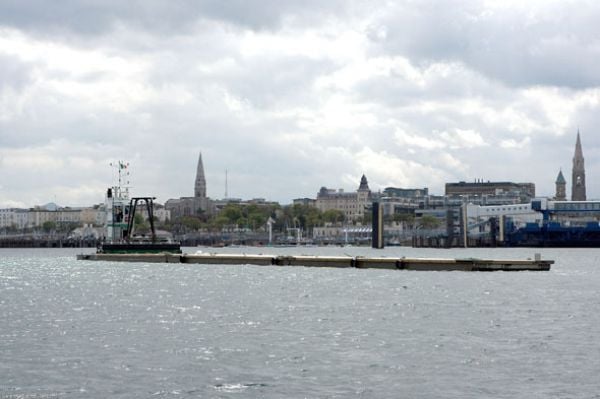
Royal St. George is Club of the Year
The assessors in the Mitsubishi Motors/Irish Independent "Sailing Club of the Year 2010" adjudication have placed a strong emphasis on national and international sailing success in analysing the overall achievements of the past year.
Little wonder, then, that the Royal St George Yacht Club in Dun Laoghaire took the gong this year. Commodore Patrick Blaney has led its large and energetic membership through a cracker of a year since he took over the top post in March 2009. In fact, success in the new year has already been logged with long-time member Adrian Lee winning overall with his Cookson 50 in the new international offshore classic, the RORC Caribbean 600 in February.
Then the club's team racing ace, John Sheehy, began to slice through the developing Irish match-racing scene, winning the first regional event at Dromineer in April, and taking the national title at Kinsale in October. Meanwhile the Irish offshore season was getting under way, and though the popular biennial 266-mile Dun Laoghaire to Dingle Race is run by the neighbouring National YC, the Royal St George made hay in the record fleet, with Mick Cotter's 78ft Whisper taking line honours and setting a new course record, while Cathal Drohan and Paul Egan's X41 Legally Blonde won overall on corrected time.
The club has a very active junior section, and it was rewarded by international success in 2009, with Matty O'Dowd taking the Laser Radial Europe Cup in Denmark, and the Irish Nationals on Lough Derg. Back home, the RStGYC was at the heart of the hectic four day Volvo Dun Laoghaire Regatta in July, and member Flor O'Driscoll took the top title with his superbly crewed J/24.
August saw Mick Cotter's Whisper in action again, placing best of all Irish boats in the Fastnet Race, a fifth overall in the huge fleet, putting her ahead of many racing machines, and first of the cruiser-racers, a placing she repeated at the Maxi Worlds in Sardinia in September. At home during August, the club hosted the Optimist Irish Nationals, the largest one design event in Ireland in 2009 with 243 junior helms racing in demanding conditions, doubly useful as Royal St George will be staging the World Youth Sailing Championships in 2012.

(l to r) Frank A. Keane (Mitsubishi Motors Ireland) & Commodore Patrick Blaney (RStGYC)
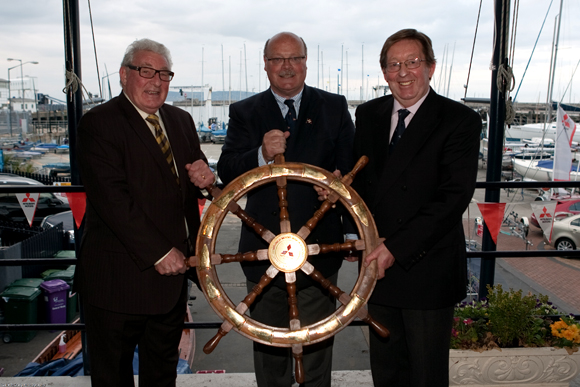
(l to r) Frank A. Keane (Mitsubishi Motors Ireland), Commodore Patrick Blaney (RStGYC) & Winkie Nixon (Irish Independent / Afloat Magazine)




























